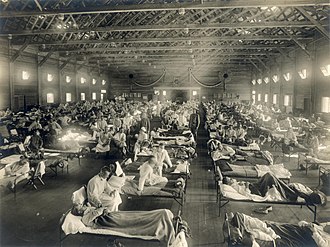Spanish flu https://upload.wikimedia.org/wikipe
Post# of 129032

Soldiers from Fort Riley, Kansas, ill with Spanish flu at a hospital ward at Camp Funsto
https://en.wikipedia.org/wiki/Spanish_flu
The 1918 influenza pandemic (January 1918 – December 1920; colloquially known as Spanish flu) was an unusually deadly influenza pandemic, the first of the two pandemics involving H1N1 influenza virus.[1] It infected 500 million people around the world,[2] including people on remote Pacific islands and in the Arctic.
Probably 50 million and possibly as many as 100 million (three to five percent of Earth's population at the time) died, making it one of the deadliest epidemics in human history.[3][4][5] Historical and epidemiological data are inadequate to identify with certainty the pandemic's geographic origin.[2]
Infectious diseases already limited life expectancy in the early 20th century. But in the first year of the pandemic, life expectancy in the United States dropped by about 12 years.[6][7][8] Most influenza outbreaks disproportionately kill the very young and the very old, with a higher survival rate for those in-between. But the 1918 pandemic resulted in a higher than expected mortality rate for young adults.[9]
To maintain morale, wartime censors minimized early reports of illness and mortality in Germany, the United Kingdom, France, and the United States.[10][11] Papers were free to report the epidemic's effects in neutral Spain (such as the grave illness of King Alfonso XIII).[12] These stories created a false impression of Spain as especially hard hit,[13] thereby giving rise to the pandemic's nickname, "Spanish flu".[14]
Scientists offer several possible explanations for the high mortality rate of the 1918 influenza pandemic. Some analysis have shown the virus to be particularly deadly because it triggers a cytokine storm, which ravages the stronger immune system of young adults.[15]
In contrast, a 2007 analysis of medical journals from the period of the pandemic[16][17] found that the viral infection was no more aggressive than previous influenza strains.
Instead, malnourishment, overcrowded medical camps and hospitals, and poor hygiene promoted bacterial superinfection. This superinfection killed most of the victims, typically after a somewhat prolonged death bed.
Academic Andrew Price-Smith has made the argument that the virus helped tip the balance of power in the latter days of the war towards the Allied cause. He provides data that the viral waves hit the Central Powers before the Allied powers and that both morbidity and mortality in Germany and Austria were considerably higher than in Britain and France.[27]
Despite the high morbidity and mortality rates that resulted from the epidemic, the Spanish flu began to fade from public awareness over the decades until the arrival of news about bird flu and other pandemics in the 1990s and 2000s.[95] This has led some historians to label the Spanish flu a "forgotten pandemic".[23]
There are various theories of why the Spanish flu was "forgotten". The rapid pace of the pandemic, which, for example, killed most of its victims in the United States within less than nine months, resulted in limited media coverage.
The general population was familiar with patterns of pandemic disease in the late 19th and early 20th centuries: typhoid, yellow fever, diphtheria, and cholera all occurred near the same time. These outbreaks probably lessened the significance of the influenza pandemic for the public.[96] In some areas, the flu was not reported on, the only mention being that of advertisements for medicines claiming to cure it.[97]
Also, the outbreak coincided with the deaths and media focus on the First World War.[98] Another explanation involves the age group affected by the disease. The majority of fatalities, from both the war and the epidemic, were among young adults.
The number of war-related deaths of young adults may have overshadowed the deaths caused by flu. When people read the obituaries, they saw the war or postwar deaths and the deaths from the influenza side by side. Particularly in Europe, where the war's toll was high, the flu may not have had a tremendous psychological impact or may have seemed an extension of the war's tragedies.[67].
The duration of the pandemic and the war could have also played a role. The disease would usually only affect a particular area for a month before leaving. The war, however, had initially been expected to end quickly but lasted for four years by the time the pandemic struck.
Regarding global economic effects, many businesses in the entertainment and service industries suffered losses in revenue, while the health care industry reported profit gains.
 (1)
(1) (0)
(0)